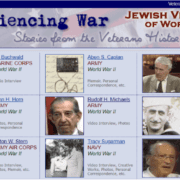Veterans History Project -Preserving Stories of Service
By Kerry Ward, Veterans History Project Liaison Specialist
Jacob Weinstein. Melvin Cohen. Bonnie Koppell.
These names may not be etched into popular memory, but they fought unrelenting bigotry in two World Wars, battled communist forces within the jungles of Vietnam, and operated peacekeeping missions in some of the most difficult environments in the world. With their brothers and sisters in arms, they followed a long tradition of Jewish Americans who have heeded the call to serve and, in doing so, helped form the fabric of our military, history, culture, and society. They faced barrages of artillery in the trenches of France during The Great War, flew bombing missions over Germany during World War II and counseled the men and women on the front lines during the most recent conflicts. By sharing their diverse experiences, we as a nation can begin to understand their immeasurable contributions.
Created by Congress in 2000, the Library of Congress Veterans History Project (VHP) includes those treasured stories of service and over 112,000 other first-person narratives of U.S. veterans and Gold Star family members. As a grassroots effort, volunteers around the nation help the veterans in their lives and communities gather and submit audio and video oral history interviews, original photographs, letters, diaries, and other documents chronicling their time in the military. These collections create a lasting record of service, while simultaneously providing an invaluable cultural resource that informs the historical record and illuminates the times in which our nation’s veterans lived. Our repository is full of information that focuses solely on veterans’ personal experiences – memories of what they did, saw and felt- no matter their branch, rank or religious affiliation.
Those of Jewish heritage have served our nation since before the Revolutionary War and have continued to serve through every U.S. conflict. More than half a million Jewish Americans served in the U.S. Armed Forces during World War II.
Fighting Nazi Germany took on special significance for this group of U.S. servicemen in the European Theater. Even those Jewish soldiers, airmen, Coast Guardsmen, Marines, and sailors who were serving elsewhere in World War II understood that defeating the Axis would be a defeat for blind hatred of any ethnic group or nationality. First-person accounts of 10 veterans of the Second World War are spotlighted in one of VHP’s Experiencing War online exhibits, titled Jewish Veterans of World War II.
One veteran included in the exhibit is Milton Stern, who enlisted in the Army Air Force in October 1941, six weeks before the attack on Pearl Harbor. Fresh out of high school in Rochester, New York, he was working in a defense-related job which might have exempted him from service, but he was determined to serve in uniform. By March 1944, he was flying as a navigator in a B-17 in bombing missions over Germany.
The enemy shot down his plane over Holland and after 10 months of being sheltered by Dutch partisans, he was captured and sent to a prisoner of war camp. Being captured relatively late in the war had its advantages. Stern’s captors knew he was Jewish, but they were too distracted by the advancing Allied forces to transfer him to a death camp. He kept a secret diary, which detailed his dwindling rations, as well as wish lists. By May 1, 1945, the German guards had fled the camp and the prisoners’ Russian liberators had arrived.
Not included in the exhibit, but available in the online database is the oral history of Dr. Henry Heimlich, who accepted an assignment as a U.S. Navy chief medical officer at Camp Four of the Sino-American Special Technical Cooperative Organization (SACO) located in northern China. Following the war, Heimlich continued to think of a Chinese soldier he saw die from a bullet wound to the chest. This experience led to the creation of the Heimlich Chest Drain valve, which helps save individuals with a collapsed lung. This valve would go on to save countless lives during the Vietnam War. His innovations continued and he is credited with creating the first aid procedure popularized in 1974 called the Heimlich maneuver.
Jewish veterans continued to make impacts throughout the U.S., whether during a conflict or peacetime, through traditional military occupational specialties and those not as common. Rabbi Israel Drazin served during the Cold War and was the first person of the Jewish faith to serve as the Army’s Assistant Chief of Chaplains. As a lawyer, the Army called on him to defend the constitutionality of military chaplaincies. When he won that case, he helped to open the door for chaplains to serve people of all faiths, as well as atheists.
Regardless of whether Jewish American service members ventured onto foreign soil or supported efforts stateside, the ones who chose to tell their stories are contributing to the record of human understanding and the evolution of American society. If you are a veteran, share your story with VHP so we can add it to the national repository for future generations. If you have a veteran in your life, even if they are deceased, VHP welcomes you to submit their personal narrative and/or original materials as soon as you can.
You can download a VHP How-to Field Kit at www.loc.gov/vets, check out the adapted training materials and guidance for library users engaged in VHP collecting activity in person or via remote interviews.
Volume 75. Number 4. 2021




